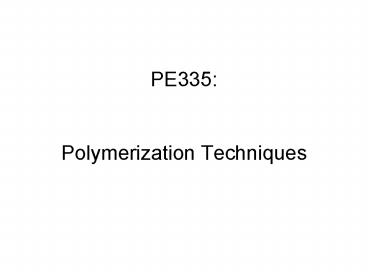PE335: Polymerization Techniques - PowerPoint PPT Presentation
1 / 19
Title:
PE335: Polymerization Techniques
Description:
... purification steps etc. Monomer Technique/Reactor Reaction conditions Initiator/Catalyst Polymer resin Compounding ... and lubricant additives ... PVC, PMMA ... – PowerPoint PPT presentation
Number of Views:626
Avg rating:3.0/5.0
Title: PE335: Polymerization Techniques
1
PE335Polymerization Techniques
2
Production Steps
Monomer
Co-monomer(s)
- Type of polymerization
Co-catalysts Donors etc.
Initiator/Catalyst
Technique/Reactor
Reaction conditions
Compounding/Processing
Polymer resin
End Product
3
Polymerization Techniques
- 1. Homogeneous systems
- 1.1. Bulk polymerization
- 1.2. Solution polymerization
- 2. Heterogeneous systems
- 2.1. Suspension polymerization
- 2.2. Emulsion polymerization
- 2.3. Precipitation polymerization
- 2.4. Polymerization in solid state
- 2.5. Polymerization in the gas phase
4
Advantages and Limitations
5
Choice of Polymerization Technique
Sometimes for one monomer several techniques of
polymerizing are available. Choice of a specific
technique depends on certain factors
- Kinetic / mechanistic factors related to chain
length, chain composition - Technological factors e.g. heat removal, reaction
rate, viscosity of the reaction mixture,
morphology of the product - Economic factors production costs, environmental
aspects, purification steps etc.
6
Bulk Polymerization
- Neat monomer (and initiator)
- Simplest formulation and equipment
- Most difficult in control, when polymerization
is very exothermic - Common problems (1) heat transfer (2) increase
in viscosity - If polymer is insoluble in monomer ? polymer
precipitate - (1) viscosity would remain similar
- (2) occlusion of radicals (within the polymer
droplet) is unavoidable - Radical occlusion ? autoacceleration ?
crosslinked polymer nodules - (i.e. popcorn polymerization)
- The crosslinked nodules (light weight and large
volume) may cause - fouling or fracture of the polymerization
apparatus
Commercial uses
- Casting formulations
- Low MW polymers for adhesives, plasticizers,
tackifiers, - and lubricant additives
7
Suspension polymerization
- Disperse monomer droplets in a noncompatible
liquid (e.g. H2O) - Polymerize the monomer by an initiator (soluble
in the monomer) - Stabilize the dispersion with a stabilizer (e.g.
poly(vinyl alcohol) or methyl cellulose) - Isolate granular bead products by filtration or
spray drying - Heat transfer is efficient and reaction is
easily controlled - Similar to bulk polymerization in kinetics and
mechanism
Commercial uses
For making granular polymers, e.g. PS, PVC, PMMA
8
Solution Polymerization
- Use monomer solution
- Heat transfer is very efficient
- MW may be severely limited by chain transfer
reaction - (probably caused by the solvent molecule or
its impurities) - Solvent residues ? difficult to remove
completely - Environmental concerns ? organic solvent waste
Use supercritical CO2 as a polymerization solvent
? nontoxic, inexpensive,
easily removed and recycled
9
Solution Polymerization
10
Emulsion polymerization
- Emulsification
- Add emulsifying agent (e.g., soap or detergent)
in an aqueous solution - ? to form micelles
- Monomers enter and swell the micelles
- Initiation
- Radicals (redox type) are generated in the
aqueous phase and diffuse - into micelles
- Propagation
- Polymerization propagated within micelles
- More monomers enter micelles to support the
polymerization - Termination
- Termination by radical combination when a new
radical enters the - micelle
- Results
- Extremely high MW are obtainable, but often too
high to be useful - Chain transfer reagents are often added to
control the MW - Also suitable for tacky polymers (? small
particles are relative stable and - can resist agglomeration)
11
(No Transcript)
12
Stages of Particle Growth
- Three different stages
- Nucleation of particles
- Particle growth in presence of
- monomer droplets
- (3) Particle growth in absence of
- monomer droplets
(Thoenes, 1991)
13
Emulsion Polymerization Recipe
- Water (continuous phase)
- Water-insoluble monomer
- Water-soluble initiator
- Surfactant
14
Emulsion Polymerization Recipe
15
(No Transcript)
16
(No Transcript)
17
Gas Phase Polymerization Light olefins
- Fluidized bed polymerization
18
Hybrid Reactor for Polypropylene
- The process is a mass polymerization of
propylene - A catalytic system is prepared and made to react
in a controlled manner with a small amount of
liquid propylene, inside a small- capacity
reactor (prepolymer) - 2) The product of the pre-polymer is taken to the
Loop tubular reactors (pressure of 32 bars and
70C) for further polymerization .
3) Separation of the non-reacted monomer from the
solid polymer by gasification of the (un-reacted)
liquid propylene. 4) The polypropylene is washed
with water vapor to eliminate any still- active
catalyst, then dried with hot nitrogen. 5) PP is
compounded according to the requirements of its
specific application.
19
End































